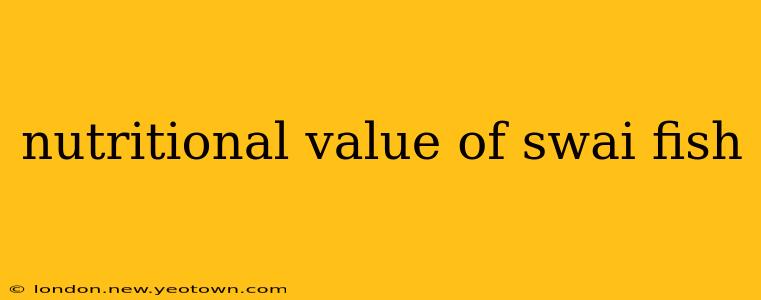Swai fish, a popular and often affordable option in many supermarkets, has sparked considerable debate among health-conscious consumers. While its low price point makes it attractive, concerns about its farming practices and nutritional profile often linger. Let's delve into the facts and separate the myths from the reality surrounding this often-misunderstood fish.
My journey into understanding swai fish began with a simple question: Is it a healthy choice? This led me down a path of researching its nutritional value, farming methods, and overall impact on our health and the environment. What I uncovered was a nuanced picture, one that demands a closer look before making any assumptions.
What is Swai Fish?
Swai, also known as basa, is a white, flaky fish originating from Southeast Asia. Its mild flavor makes it versatile in the kitchen, lending itself to various cooking methods. However, the way it's raised is a crucial factor impacting its nutritional value and overall sustainability. Much of the swai sold internationally comes from intensive aquaculture farms, raising concerns about potential environmental and health impacts.
What is the Nutritional Value of Swai Fish?
Swai fish is a relatively lean source of protein, offering a decent amount per serving. However, its nutritional profile isn't as impressive as some other fish varieties. Let’s break it down:
- Protein: Swai is a good source of protein, essential for building and repairing tissues.
- Fat: It’s relatively low in fat, making it a suitable choice for those watching their fat intake. However, the type of fat can vary depending on the fish's diet and farming practices.
- Vitamins and Minerals: Swai offers modest amounts of certain vitamins and minerals, including vitamin B12 and selenium. However, it's not a powerhouse of micronutrients.
It's important to remember that the nutritional content can fluctuate based on factors like the fish's diet and farming conditions.
Is Swai Fish Healthy?
This is arguably the most important question, and the answer is nuanced. While swai offers protein and some essential nutrients, it's not necessarily the healthiest fish option. The farming practices often associated with swai production raise concerns. Intensive farming can lead to higher levels of fat and potentially higher levels of contaminants. This doesn't mean all swai is unhealthy, but it highlights the importance of choosing responsibly sourced fish whenever possible.
What are the potential health concerns of eating swai fish?
This is a valid concern given the farming practices. Potential issues include:
- Higher Fat Content: Intensive farming may lead to a higher fat content compared to wild-caught fish.
- Contaminants: The possibility of higher levels of contaminants like pesticides and antibiotics exists due to farming practices. However, reputable suppliers adhere to strict regulations to minimize these risks.
- Sustainability Concerns: The intensive farming methods used for swai production often have negative environmental impacts.
How does the nutritional value of swai compare to other fish?
Compared to other popular fish like salmon or tuna, swai is generally lower in omega-3 fatty acids and other beneficial nutrients. Salmon, for example, is packed with omega-3s, known for their heart-healthy benefits, a characteristic less pronounced in swai.
Is swai fish safe to eat?
Yes, swai fish is generally considered safe to eat, provided it is sourced from reputable suppliers and handled properly. However, awareness of potential contaminants and the environmental impact of its farming methods is crucial. Choosing sustainably sourced swai or opting for other, more sustainable fish varieties is always recommended.
What are the best ways to prepare swai fish?
Swai's mild flavor makes it incredibly versatile. It can be baked, grilled, pan-fried, or even included in fish tacos or other dishes. Avoid overcooking it, as this can make it dry.
In conclusion, swai fish offers a source of protein and some micronutrients but isn’t necessarily a nutritional superstar compared to other fish options. Its sustainability and potential for contaminants are valid concerns. Making informed choices, prioritizing sustainable sourcing, and diversifying your seafood consumption are key to maximizing the health benefits while minimizing potential risks.

